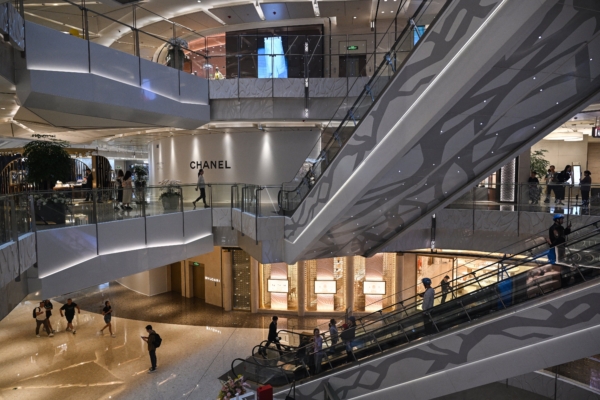China’s shopping centers and department stores are struggling to survive, with traditional retail enterprises facing a sharp decline in profits. According to the third-quarter reports of 20 listed retail companies, only 2 companies achieved growth in both revenue and profits. Well-known businesses such as Wangfujing and Xidan Shopping Mall have been closing multiple stores this year, leading to a stark comparison to the bustling crowds seen when these establishments first opened.
The mainland’s fast-moving consumer goods professional media platform, “New Distribution,” reported on Friday (November 21) that after analyzing the financial reports of 24 retail listed companies for the first three quarters, it was found that only 2 companies achieved growth in both revenue and profits. Based on the financial reports, it was revealed that the combined profits of the 20 traditional retail enterprises amounted to only 778 million yuan, a sharp 88.9% decrease compared to 69.8 billion yuan in 2024. Among them, 10 companies experienced profit declines of over 50%, with companies like Yu Garden, Central Shopping Mall, and Guang Bai seeing declines exceeding 100%.
These enterprises include both well-established retailers like Wangfujing, Yu Garden, and Dalian Friendship, as well as supermarkets like Yonghui and Suning Yigou, and snack stores like Liangpin Puzi, covering various types of businesses in the retail sector.
Wangfujing, a prominent department store, saw a 9.3% decline in revenue and a 71.02% drop in net profit in the first three quarters of this year. Apart from declining performance, Wangfujing has also been continuously closing stores throughout the year. For instance, on February 14, Beijing New Yansha Holdings, a subsidiary of Wangfujing, announced the closure of three stores at Beijing Golden Resources New Yansha MALL on April 1 this year.
Investigations revealed that in addition to Wangfujing, several other long-standing department stores have closed in the latter half of the year. Beijing’s 31-year-old Parkson’s store at Furamax announced its closure on December 31. Shenzhen’s 15-year-old Henggang Rainbow Mall ceased operations on September 15. Lanzhou’s over 20-year-old New World Department Store officially ceased operations on September 1.
Amidst a wave of closures, the vacancy rate in shopping centers is expected to increase. According to recent reports citing data from the “2025 China Commercial Real Estate White Paper,” the vacancy rate in key cities nationwide has risen to 14.2%, with some third-tier cities experiencing rates exceeding 22%, far beyond the caution line of a 6% vacancy rate.
Understanding the reasons behind the recent surge in mall closures, financial and economic media outlet “Deep Fintech New Consumption” analyzed three main factors. Firstly, economic downturns in recent years have caused a tightening of purse strings for many individuals. Layoffs at internet giants, salary reductions in the financial sector, and the departure of foreign companies have led to reduced spending power for the majority of the population, resulting in downgraded consumption and luxury retailers like Wangfujing and Xidan Shopping Mall being the first to be abandoned.
Secondly, the rise of new e-commerce and retail models has squeezed the survival space of traditional shopping centers. In the age of e-commerce, prices are more transparent, weakening the dominance of traditional shopping center product pricing, making it easier for consumers to find alternatives online. New retail models like flash sales on Taobao and fast delivery on JD have attracted a significant number of consumers.
Lastly, the emergence of new types of shopping centers and oversaturation of shopping centers and malls are also significant factors. Data shows that as of 2024, there were over 6700 retail projects with an area of over 30,000 square meters in operation nationwide. In the first half of 2025, more than 120 new projects have been launched across the country. For instance, Shanghai has one large shopping center for every 80,000 residents, whereas Tokyo averages one large shopping center for every 200,000 residents.

